Category: Success Story
SkillStack® enhances law enforcement education at Idaho State University
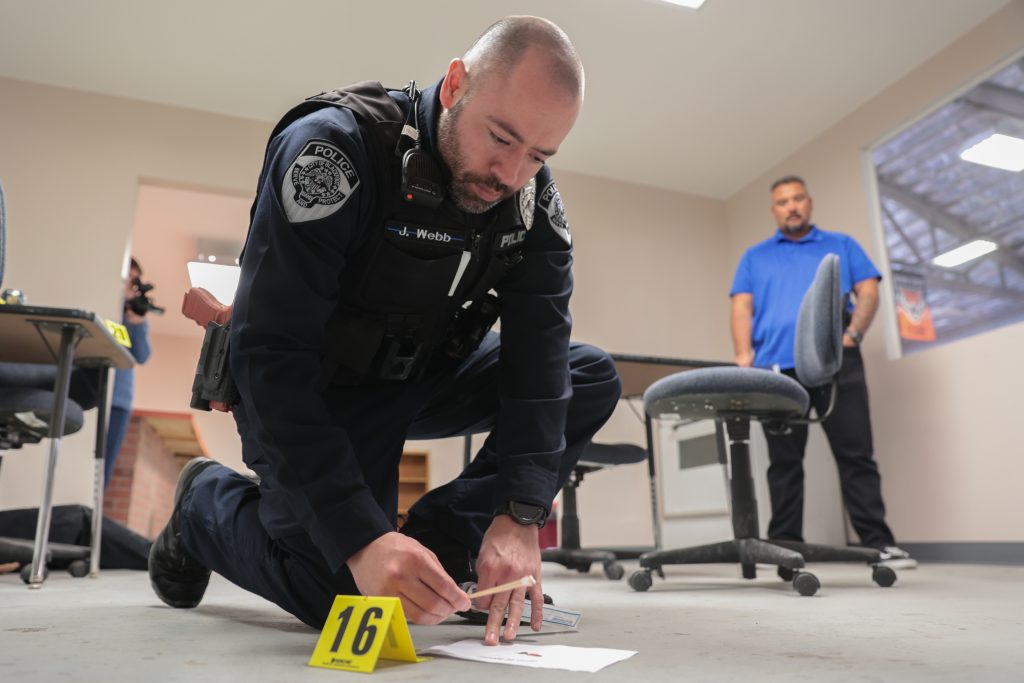
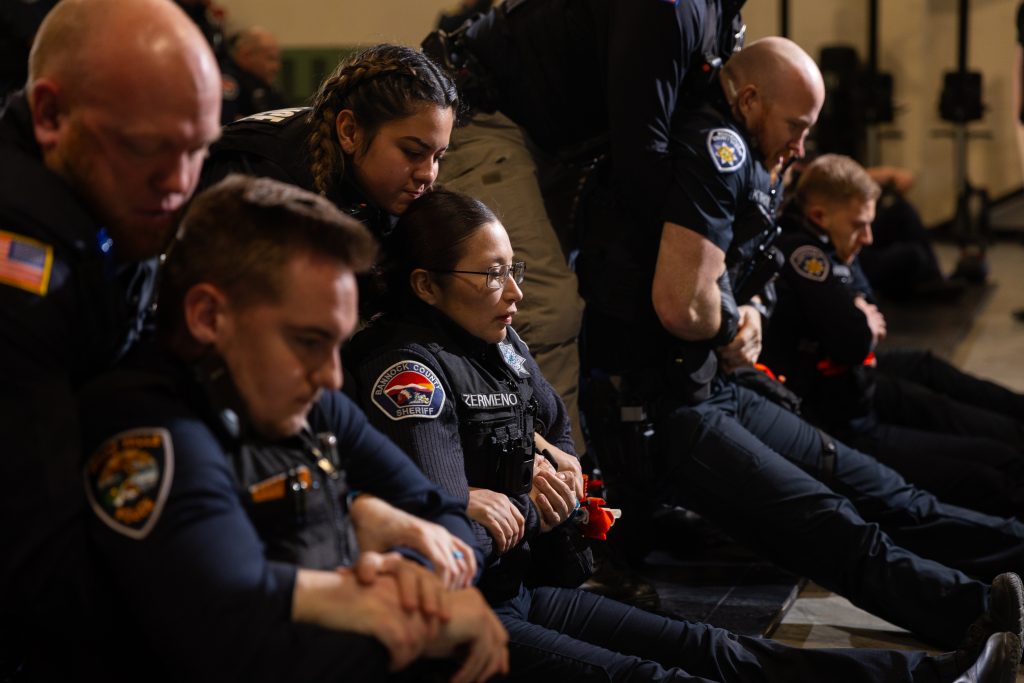
Historically, the Idaho State University (ISU) Law Enforcement Program attracted only three to four students each semester who enrolled at ISU without prior connections to law enforcement agencies. Instead, most of the law enforcement participants had already been hired by a local law enforcement agency but needed to complete their Peace Officer Standards and Training (POST) to continue working, with their agencies covering the costs of their coursework through the WTC. Because of this enrollment process, these students weren’t enrolled as degree-seeking students, so they couldn’t receive ISU credit toward a certificate for their efforts.
To earn a degree, which benefits career advancement, these students previously had to navigate an extensive prior learning assessment process. However, this approach saw little success, with very few applications submitted over the program’s history. The program aimed to find a more effective way to recognize students’ accomplishments while satisfying the requirements for a Basic Technical Certificate (BTC).
The IDCTE SkillStack® microcredentialing program offered a unique solution to this challenge.
I can use the college credits I earned while [I also] obtain my Idaho POST Certification.
Benjamin Avolio, ISU Law Enforcement student
ISU faculty contacted IDCTE to discuss converting existing coursework into a series of stacked badges. After the university provost, registrar and College of Technology dean granted provisional approval for the process to begin as a pilot, the IDCTE team aligned the badges with the law enforcement curriculum, demonstrating how the activities associated with the badges matched the courses’ learning outcomes. A key challenge was ensuring that students could enroll without incurring extra costs. To address this, the ISU team created a zero-credit course, allowing students to pay an application fee to ISU. After completing the coursework, instructors log achievements in SkillStack® and send a memo of completion to the university registrar to award academic credit. This streamlined process integrated practical training with academic recognition, enabling students to apply for graduation.
“SkillStack® is a neat program. I can use the college credits I earned while [I also] obtain my Idaho POST Certification,” said Benjamin Avolio, a current ISU Law Enforcement student.
Since implementing SkillStack®, the number of BTC recipients in the law enforcement program increased dramatically, from 15 over five years to 38 in the first year. More importantly, law enforcement agencies have expressed strong support for the program, encouraging their officers to participate to enhance career prospects.
By sharing this successful model, ISU aims to improve law enforcement training across Idaho and foster cooperation among educational institutions, with the College of Western Idaho and CSI expressing interest in adopting SkillStack® for their programs. Overall, the SkillStack® microcredentialing program at ISU represents a significant shift in law enforcement education, enhancing the educational experience for students and contributing to more effective training in the state. This innovative approach sets a precedent for similar initiatives in other programs and institutions.
Adult Education Student of the Year earns GED, phlebotomy certificate
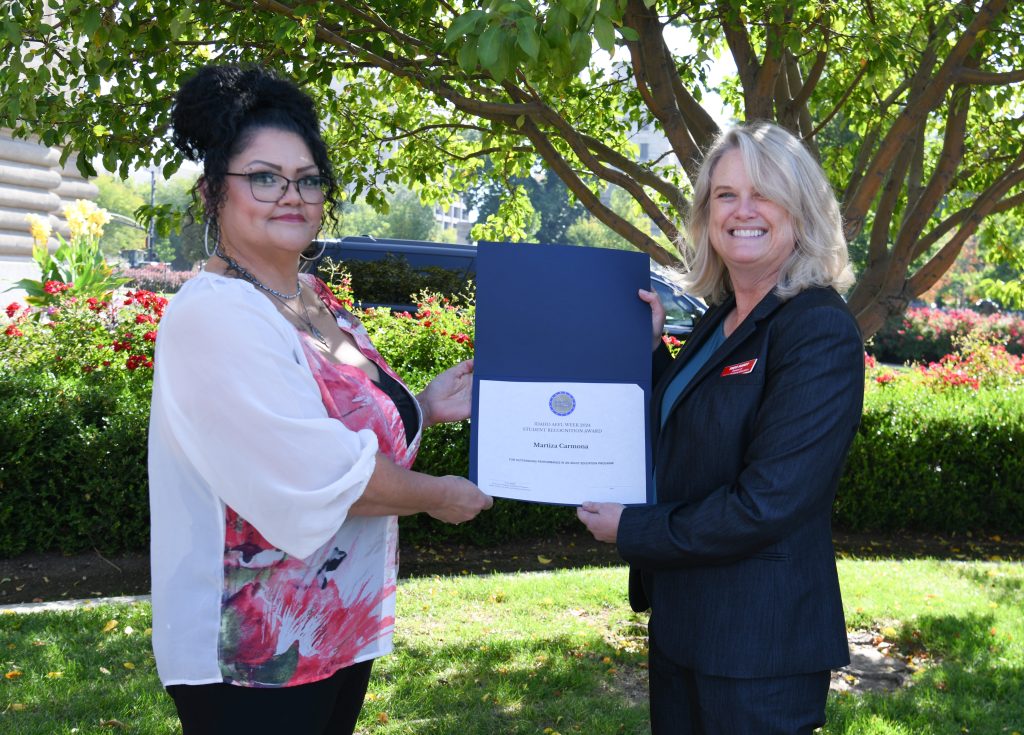
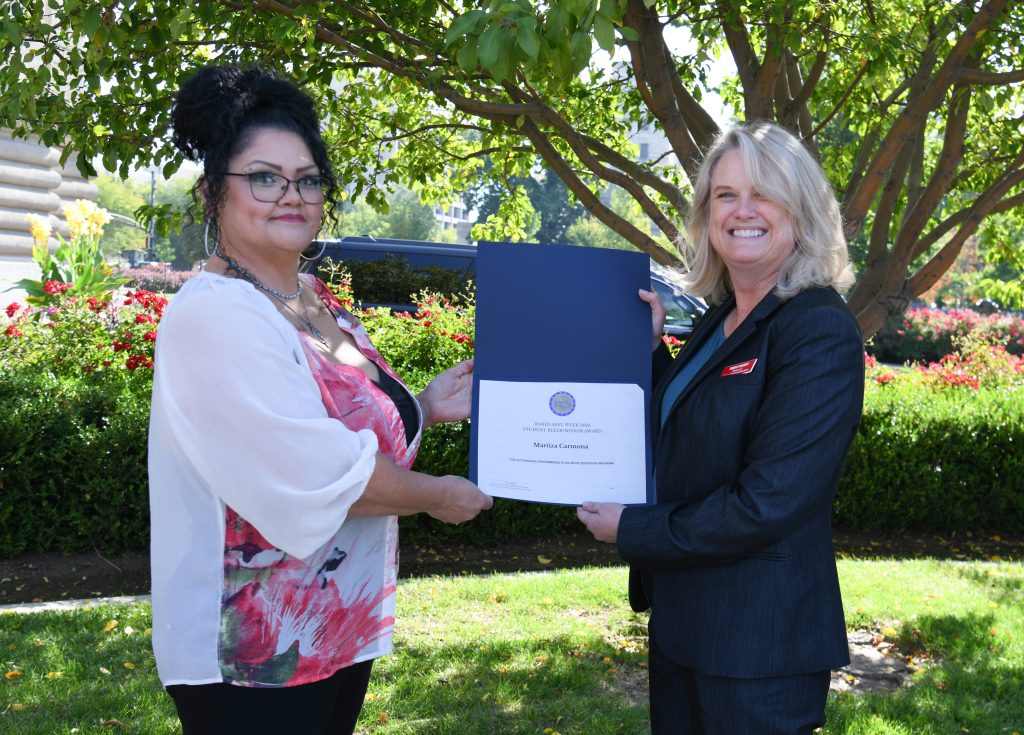
Maritza Carmona, 47, a mother of four and grandmother of 14, dropped out of school in 1993 in the ninth grade to raise her first son. Though she always intended to finish her education, she realized later that earning her GED was essential to move forward. It wasn’t until her youngest child turned 21 last year that Carmona decided to focus on her own goals.
She enrolled in GED classes at the College of Southern Idaho (CSI) while simultaneously working as a DoorDash driver. Balancing work and study, Carmona turned her car into a mobile classroom.
“I did my homework between deliveries, with books on my lap, working on math or reading while waiting for the next order,” said Carmona. “I worked long hours, sometimes from 7 a.m. until 10 or 11 p.m., but it was worth it to stay in class.”
Throughout this process, Carmona’s teachers and fellow students provided critical support.
“I had two great teachers who encouraged me to keep going,” she said. “They helped me believe in myself, even when I doubted my ability.”
Carmona’s path wasn’t without challenges. She encountered difficulties with some of her classes, particularly math.
“I struggled with the way my teacher explained things. I just couldn’t grasp her method,” said Carmona.
But she wasn’t the only one. Other students had the same issue, so they started helping each other out. Together with her classmates, Carmona advocated for a slower pace and clearer explanations.
“I spoke up for the group, and we were able to ask the teacher to slow down and go over things more thoroughly,” said Carmona. “It helped everyone.”
Getting your GED is not just a piece of paper. It’s a key to everything. It opens doors for me and for anyone who is willing to put in the effort, and no one can take that key away from you.
Maritza Carmona, 2024 Adult Education Student of the Year
Despite feeling overwhelmed at times, Carmona kept pushing forward, motivated by the support of her family.
“My kids kept reminding me that my mom, who had passed away in 2021, was watching over me,” said Carmona. “They told me she would be proud of me.”
After earning her GED, Carmona used funding from Idaho LAUNCH to pursue a phlebotomy certification, which opened more career opportunities. She now works as a Certified Nursing Assistant and phlebotomist at Family Health Services in Jerome, Idaho. Looking ahead, Carmona plans to advance further in the medical field, with aspirations to become a Certified Medical Assistant (CMA) or Licensed Practical Nurse. She credits her GED as the key that unlocked these opportunities. For her tenacity, perseverance, and advocacy for herself and other students, Carmona was named Idaho’s 2024 Adult Education Student of the Year.
“On the day I found out, I was feeling down, doubting myself, wondering if I could keep up with everything,” said Carmona. “When I got the message that I was Student of the Year, it brought me to tears. I realized—wow, people are noticing me, even when I didn’t think anyone was paying attention.”
In recognition of her achievement, Carmona was invited to attend Governor Little’s Adult Education and Family Literacy Week proclamation signing on Sept. 20, 2024, in Boise.
Carmona’s advice to others considering returning to school is simple: Don’t let age or self-doubt hold you back.
“Age shouldn’t be an excuse to not better yourself,” said Carmona. “Getting your GED is not just a piece of paper. It’s a key to everything. It opens doors for me and for anyone who is willing to put in the effort, and no one can take that key away from you.”
Teacher’s vision brews a future filled with opportunity for her students


With just 70 students in grades nine through 12, Council High School (CHS) may be small, but its FCSHS teacher, Jodi Cook, has big ambitions. Since 1992, Cook has been inspiring students with her passion for culinary arts, which took root during her own junior high experience. Her involvement in Future Homemakers of America (now FCCLA) and national culinary competitions in high school further fueled her desire to teach FCSHS.
Three years ago, Cook envisioned a student-run coffee shop to enhance her culinary arts program. This dream became a reality when the school remodeled its library, transforming a small closet into Jack’s Coffee Shop, named after the school’s mascot, the Lumberjacks. A Program Quality Initiative (PQI) grant provided the funding for the necessary commercial equipment, allowing Cook’s initiative to come to life.
The coffee shop offers students the chance to earn valuable certifications for careers in the food service industry. All students earn an online barista certification and the Idaho-specific Ready, Set, Food Safe Certification. Some even earn the ServSafe Manager Certification, which demonstrates advanced knowledge in food safety and sanitation.
“Running the coffee shop helps students develop essential skills,” said Cook. “They build teamwork and a strong work ethic as they manage daily operations, research drink trends, and adapt to customer preferences.”
I check in with them occasionally, but the coffee shop is entirely student-run and self-sustaining.
Jodi Cook, FCSHS teacher
Jack’s Coffee Shop operates on weekdays from 7:30 to 8 a.m. Monday through Thursday, allowing students to manage it independently before classes. Students also run the coffee shop on Wednesdays during lunch. Students take pride in crafting seasonal menus and special drinks, such as the Lumberjack Special for homecoming. Recently, they introduced boba tea and nondairy alternatives based on customer feedback, displaying their ability to research and innovate.
Beyond coffee-making, the initiative teaches crucial skills in entrepreneurship, marketing and customer service. Students create drink menus, conduct surveys to understand customer needs, design promotional materials, manage inventory and handle transactions.
“I check in with them occasionally, but the coffee shop is entirely student-run and self-sustaining,” said Cook.
The practical experience gained from managing the coffee shop has enabled many students to successfully transition into jobs at local restaurants and coffee shops, including positions in nearby McCall. This initiative not only enhances their culinary knowledge but also equips them with essential workplace skills, fostering pride and a sense of community within the school.
“I wanted my students to learn how to be baristas because coffee shops are very popular,” said Cook. “This hands-on training provides them with skills they can use when they graduate. If they go to college, they could easily step right into a coffee shop, earn some money and do something positive and fun.”
CTE programs transform futures for incarcerated youth

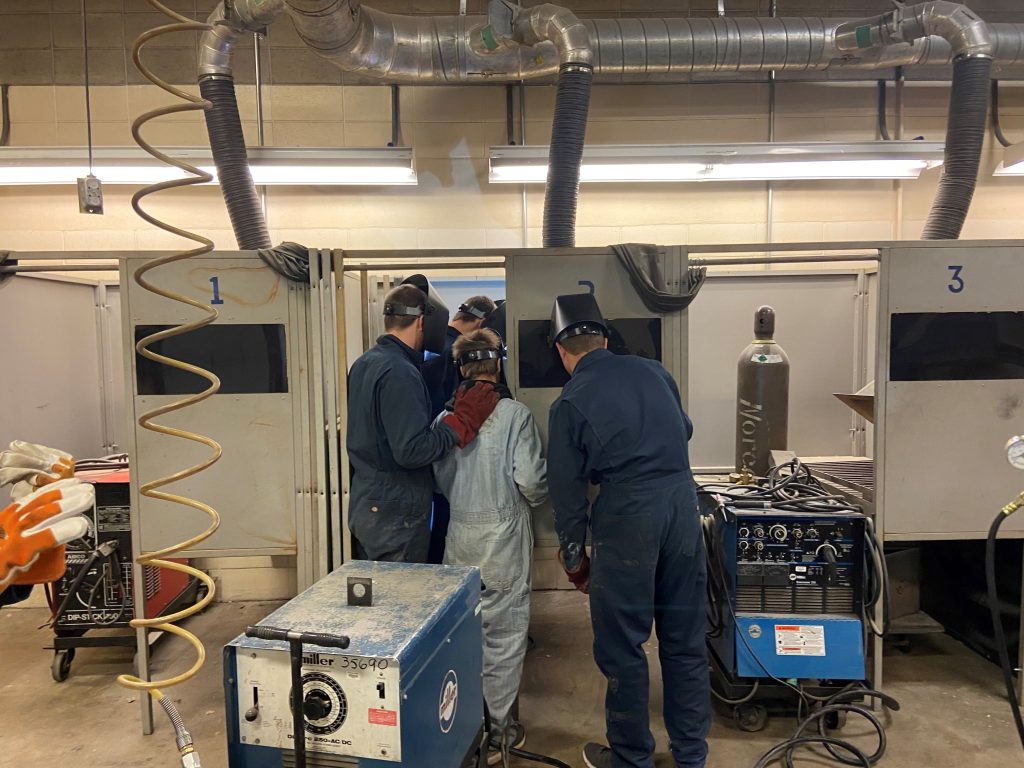
Since 2020, LCSC has collaborated with the Idaho Department of Juvenile Corrections (IDJC) to expand access to CTE programs for its residents. This initiative provides hands-on learning opportunities that can lead to real-world skills and better outcomes for incarcerated youth.
“Many of these students previously believed that education was not an option for them,” said Liz Weldy, a transition coordinator at LCSC. “Now, they’re earning dual credit or college credit, which opens doors they didn’t know were possible.”
The program began when IDJC reached out to LCSC to discuss developing more CTE opportunities for its residents. Initial discussions revealed significant barriers. Many academic institutions declined to participate due to these challenges, but LCSC was determined to find a solution.
“Incarcerated students face strict safety protocols; they can’t communicate with anyone outside their facility except for parents during visits,” said Weldy. “That means a traditional online classroom wouldn’t work.”
LCSC developed a secure instance of the online learning platform Canvas, customizing it to lock down certain features to meet safety requirements. This approach allows students to access course materials while adhering to the necessary restrictions.
Education reduces recidivism rates, and we hope to see our efforts reflected in lower incarceration rates in the future.
Liz Weldy, transition coordinator, LCSC
Initially, LCSC offered courses in hospitality, basic electricity and heating, ventilation and air conditioning (HVAC) principles. A key feature of CTE classes is their hands-on nature, and classrooms often contain professional-grade equipment. To ensure students still had access to applied learning, Weldy had to get creative with the resources available at IDJC’s three facilities. For example, at the St. Anthony facility, students gain hands-on experience working in the Canteen, an onsite restaurant for the facility’s staff. They can also earn internship credits, aligning their practical experience with industry standards.
“They’re managing real-world tasks, from food preparation to customer service, which builds essential soft skills,” said Weldy.
The program also emphasizes support during students’ transitions back into society. Each student receives an admission letter upon enrolling, along with a CTE T-shirt to foster pride.
Looking ahead, Weldy envisions further program growth.
“We’re actively seeking grant opportunities to expand offerings like welding and other trades,” said Weldy. “The goal is to align our programs with workforce needs in the community.”
The impact of these programs is already evident.
“We’ve seen students who previously disengaged from education start to thrive,” said Weldy. “One student wrote to his parents, saying, ‘Getting my high school diploma at 16 instead of a GED was a huge accomplishment and before taking these college courses, I had decided that was good enough for me. Now, I want to pursue more! And I’m excited about doing so.’”
Feedback from educators indicates a strong demand for more CTE classes. In response, LCSC is exploring additional course offerings and certifications.
“Educators see how these programs positively influence student behavior and academic performance, and there’s interest in expanding into healthcare and science fields,” said Weldy. “Education reduces recidivism rates, and we hope to see our efforts reflected in lower incarceration rates in the future.”
BPA national champion pursues a career in education

In 2022, Sandpoint High School graduate Colton Moore embarked on an unexpected journey that would reshape his future. As the editor of his yearbook, he learned how to use industry-standard software like the Adobe Creative Suite. Although he had dabbled in photography and graphic design, business education wasn’t initially on his radar. That changed when his school’s CTE teacher and Business Professionals of America (BPA) advisor, Melinda Nieman, encouraged him to join BPA and compete in the statewide Desktop Publishing competition during his senior year.
“As a student, I was always striving for the best and focused on achieving the highest grades, whether in AP classes or yearbook. I think that mindset made me hesitant to join BPA,” said Moore. “I worried I might not meet my own high standards in the competitive setting.”
Despite his initial reservations, Moore quickly discovered that he had nothing to fear. That year, he took first place in the Desktop Publishing competition at the BPA National Leadership Conference (NLC) in Dallas. His experience at the state and national levels opened his eyes to the potential for learning and connecting with like-minded individuals.
“I realized it was about engaging with others, learning together, and sharing experiences, not just competing,” said Moore.
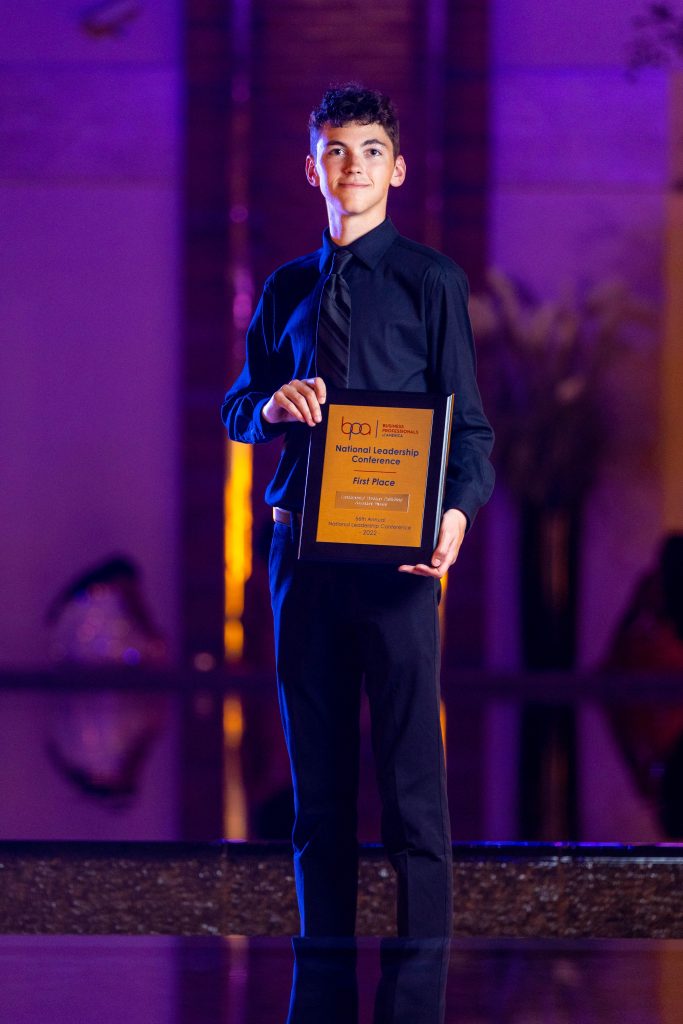
This realization was pivotal in changing his trajectory. Initially aiming to become a creative director in the business world, Moore shifted his focus to pursuing a degree in business teacher education after witnessing the value of collaboration and mentorship.
Following graduation, Moore began his academic journey at North Idaho College (NIC), where he engaged deeply with the campus community as a college ambassador. He appreciated the small class sizes and interactive learning environment, realizing through this experience the unique strengths of community colleges. After earning his associate degree, Moore transferred to the University of Idaho, where he is now a junior completing a bachelor’s degree in business and marketing education. He currently serves as the president of the University of Idaho’s postsecondary BPA chapter and plays an active role in organizing the region’s high school BPA event held on campus.
Students need these skills to succeed in both personal relationships and professional settings, particularly for those aspiring to leadership roles in business and marketing.
Colton Moore,
business and marketing education major, University of Idaho
In addition to his academic pursuits, Moore is already making strides in his professional journey by securing a paid internship with CharacterStrong, a Tacoma-based company that develops character education content for schools.
“In CTE, soft skills, such as conflict resolution and responsibility, are as important as technical skills,” said Moore. “Students need these skills to succeed in both personal relationships and professional settings, particularly for those aspiring to leadership roles in business and marketing.”
Moore credits several mentors for shaping his educational journey. Although he didn’t take a formal class with Nieman, her passion for teaching and encouragement sparked his interest in the field.
“Kevin Hutchins, my yearbook advisor for two years, was also a mentor throughout high school,” said Moore. “We had many great discussions about business, marketing and education, which inspired me to become a business teacher.”
Moore hopes to inspire future students in the same way his mentors inspired him.
“I can’t wait to bring these experiences and teaching methods into my classroom,” said Moore.
Support from Center for New Directions fuels growth in autobody program

In the bustling Autobody and Paint Technology workshop of NIC’s Parker Technical Education Center (PTEC), the sound of tools clanging and paint sprayers humming fills the air. Students work diligently at their stations, some meticulously prepping surfaces while others apply vibrant coats of paint. This dynamic environment reflects a growing trend: Among the 13 students enrolled, seven are female, marking the first time in the program’s history that women make up more than half of the class.

Part of this increase in women enrolling in nontraditional occupations is related to outreach and support for NIC’s Center for New Directions (CND), which offers essential support for single parents and displaced homemakers, as well as students going into fields traditionally held by the opposite gender.
For student Rylea Johnson, enrolling in the Autobody and Paint Technology Program was an easy next step after graduation from high school.
“I’ve always loved working with my hands,” said Johnson. “My favorite part of the program so far is the metal bodywork aspect. It’s cool to see the transformation of a vehicle from really messed up to almost perfect.”
Andy Rogge, the program’s lead instructor, thinks females becoming increasingly interested in the trades is a good thing.
“These students are great at listening to direction and also tend to be pickier on their quality of work, and that is exactly what I want to see with students as they are learning the basics of this industry,” said Rogge.
My favorite part of the program so far is the metal bodywork aspect. It’s cool to see the transformation of a vehicle from really messed up to almost perfect.
Rylea Johnson, student, NIC
To further encourage women to pursue careers in trades, the CND holds a monthly meeting called Women Wednesday, a gathering designed to create a supportive network for female students at PTEC.
“Our first Women Wednesday was so well-attended that we didn’t have enough chairs,” said Louisa Rogers, program coordinator for the CND. “It’s amazing to see so many women come together to support each other.”
Johnson acknowledges her experience is different than the other female students at PTEC.
“At Women Wednesday, they were talking about how some of them are the only female students in their program,” said Johnson. “I think it’s unusual for there to be so many girls in our program. But we all get along so well. And the guys in our program are really great and supportive. We all joke around and help each other out.”
The program shares space with the Kootenai Technical Education Center (KTEC), allowing high school students to witness advanced work firsthand. Three of the seven female students were previously KTEC students. The growing female presence in the program reflects a broader movement towards inclusivity in the trades.
“We want to show women that they belong in these fields,” said Rogers. “It’s about breaking down barriers and building confidence.”
Career technical centers celebrate 25 year milestone anniversary
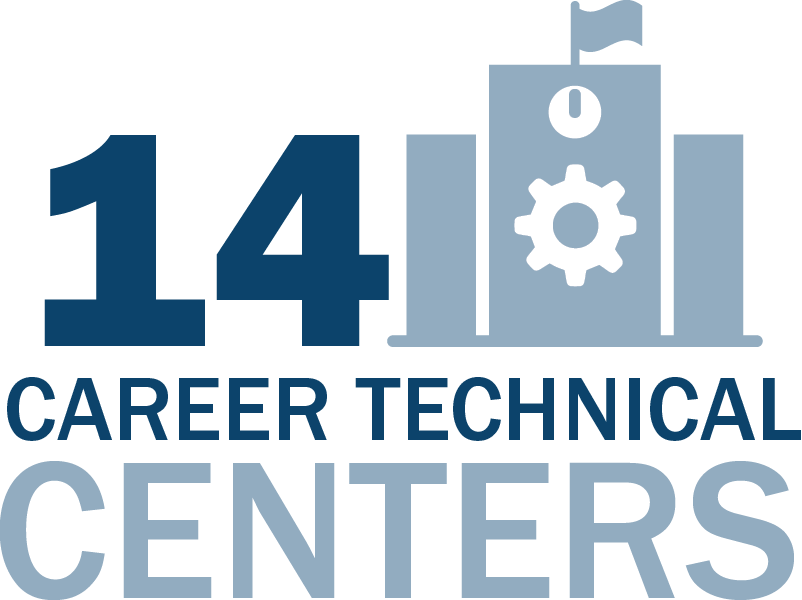
2024 marks the 25th anniversary of career technical centers (CTCs) in Idaho, highlighting their evolution and significant impact on CTE in the state. Pursuant to Idaho Code § 33-1002G and IDAPA 55.01.03.102, LEAs and cooperative service agencies must meet several criteria to qualify as a CTC. They must operate separately from other schools, have dedicated administration, offer state-of-the-art programs that prepare high school students for in-demand occupations and include opportunities to earn postsecondary credit. CTCs must also adhere to state standards, undergo a year-long planning process before opening and partner with local industries to ensure their programs remain relevant.
When CTCs were established in the 1998-1999 school year, the CTE landscape was quite different. Initially referred to as career technical schools, this framework encouraged educational programs to collaborate and share resources to enhance CTE offerings. Such partnerships facilitated the development of programs aligned with local industry demands, provided professional development for educators and strengthened connections between schools and businesses.
Each CTC has developed unique characteristics based on its location, administration and funding models. For example, the COSSA Regional Technology and Education Center in Wilder serves a regional population, transporting students from various districts to a central facility. In contrast, the Dennis Technical Education Center in Boise operates within a single district, providing local transportation for its students from high schools within the school district.
As CTCs celebrate this milestone, we reflect on their adaptability in response to evolving community needs. These centers have established themselves as vital components of Idaho’s educational landscape, preparing students for careers in a dynamic economy. The success of CTCs is evidenced by their innovation and the expansion of programs that meet the demands of current and emerging occupations.
Looking forward, CTCs will continue to play a pivotal role in providing meaningful pathways for students. Committed to delivering high-quality, state-of-the-art programs and services, these institutions will remain cornerstones of CTE, preparing future generations for success in an ever-evolving job market.


Automotive technology program bridges skills with industry demands

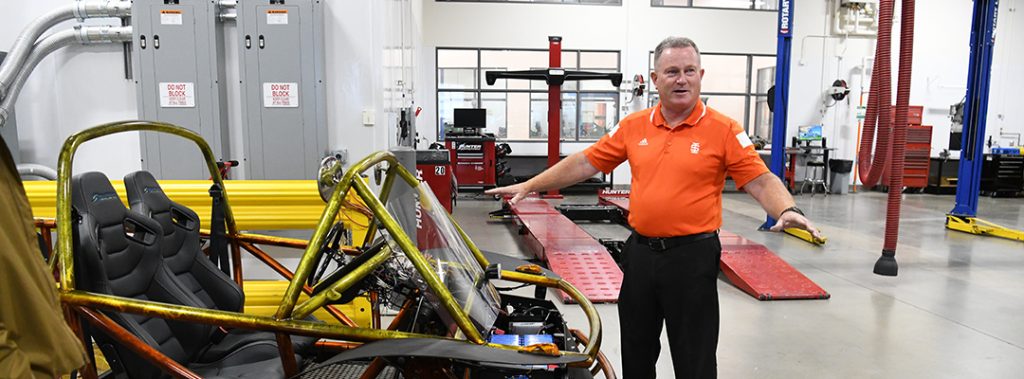
Seeing former students return and witnessing their career growth in the industry after five or 10 years, is truly satisfying.
Brock gunter
Growing up on a farm in Marsh Valley, Brock Gunter’s curiosity drove him to tinker endlessly.
“I took auto all four years of high school,” said Gunter. “My favorite classes were where I got to see how things worked and tear them apart.”
That passion led Gunter to the College of Southern Idaho, where he earned a certificate in diesel technology. For 13 years, he worked in the service department of a Pocatello car dealership. Though he loved his work, a personal connection with Dave Treasure, chair of Idaho State University College of Technology’s transportation department, changed the course of his career.
“They needed an automotive technology instructor, and it felt like a perfect fit,” said Gunter. “Eighteen years later, it still is.”
Gunter’s curriculum, accredited by Automotive Service Excellence (ASE), primes students in engine repair, transmissions, steering, brakes, electrical systems, HVAC, and engine performance. He attributes the program’s success and high job placement rates to plenty of hands-on learning opportunities.
“The last eight weeks of the program, our students focus on what we call live work,” said Gunter. “Some of them work on the cars we have in the shop, and others work in a shop in the community.”
Gunter leans on connections with his technical advisory committee (TAC) to help students find internships and job opportunities. Comprised of representatives from local dealerships and independent shop owners, their insights help Gunter align his teaching methods with industry demands, leading to program enhancements and equipment upgrades. Recent feedback from the committee led Gunter to request new diagnostic equipment and electrical trainers using funds from Governor Little’s Leading Idaho initiative. But it’s not just the hands-on learning opportunities, state-of-the-art equipment, and active and engaged TAC that draw students to Gunter’s program.
“ISU is kind of unique in that, in addition to technical certificates, students can earn an associate’s degree in two years by completing general education requirements,” explained Gunter. “There’s also a path to a four-year Bachelor of Science degree, which draws a lot of students from out-of-state.”
Gunter’s program also attracts interest from area high schools by offering dual credit.
“So I have about 10 students from all three high schools come up here for the last two hours of the day,” said Gunter. “They get the whole first semester done while still in high school, saving them time and money if they choose to continue the program after graduation.”
Regardless of where they come from or where they end up, Gunter takes immense pride in witnessing his students succeed. “Seeing former students return and witnessing their career growth in the industry after five or 10 years, is truly satisfying,” said Gunter.
Cybersecurity program leads the charge to meet growing workforce need
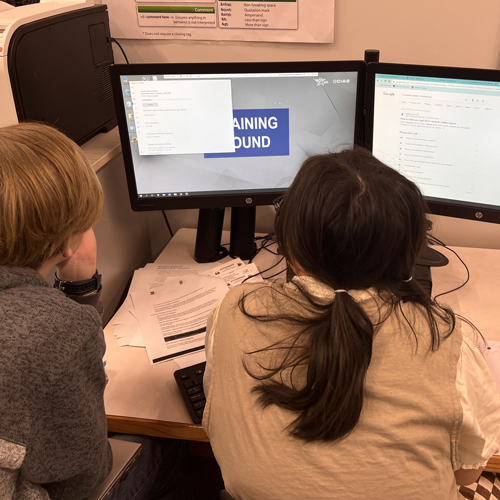

Just four years after its inception, the cybersecurity program at Idaho Falls School District No. 91’s Career Technical Education Center is already impacting the growing need for cybersecurity professionals. According to the Idaho Department of Labor, cybersecurity job openings in Idaho have increased 160% since 2015.
“Because the Idaho National Laboratory (INL) is in our backyard, it seems like they never have enough people to fill all the jobs they have in cybersecurity,” said Cathy Owen, who teaches the district’s cybersecurity classes.
Fortunately, the constant need for employees has translated into a steady stream of support for Owen’s program.
“The INL’s Cyber Corehas been phenomenal from the start,” said Owen. “They’ve provided everything from paid internships to equipment to mentors.”
In fact, some of Owen’s students discovered her program through the College of Eastern Idaho (CEI) and INL’s Cyber Core Summer Camp, which introduces freshmen thruough senior high school students and CTE teachers to cybersecurity and related topics. Students participate in hands-on learning activities, hear from industry mentors, and tour industrial facilities. The weeklong beginner course was held in Idaho Falls, Twin Falls, Boise, and Lewiston last summer, with an advanced course being held exclusively in Idaho Falls.
Through this program, Owen was introduced to Dr. Michael Haney, an assistant professor of computer science at the University of Idaho and a cybersecurity researcher at the INL. Haney, who serves on Owen’s technical advisory committee, has been instrumental in procuring resources Owen needs, like access to equipment, and use of the RADCIL Lab so students can work in a virtual network environment used for teaching cybersecurity without impacting school networks. Haney also introduced Mrs. Owen to the range and helped her secure a spot with cyber.org and their range, which is very important so students can work in a virtual environment.
It allows students to practice security techniques in a controlled, simulated space, offering hands-on experience without jeopardizing actual system. The range allows me to facilitate basic security practices to advanced threat detection in a safe, virtual environment.
Cathy owen
The summer camp has also facilitated partnerships with CEI, which offers dual credit opportunities for Owen’s students and paved the way for Security+ certification, an industry-recognized validation of foundational cybersecurity expertise.
Beyond academics, students benefit from participation in four content-related clubs, including the Cyber Patriot Program, Cyber Start America, Business Professionals of America, and, Idaho’s first high school chapter of Women in Cyber Security. These clubs foster practical application of the skills students learn in class and further their knowledge of cybersecurity.
The support and resources her students have access to have led to many promising opportunities in this growing field.
“I love hearing from my former students and having them share their experiences,” said Owen. “One of them received a full-time position at INL’s Help Desk; they’re actually earning a decent wage and getting their college experience paid.”
Digital media production program shapes future leaders in broadcasting


Davey Steele was always an athlete, so it was a natural fit when he got a work-study job running the video board, replay system, and shot clock for Vandal games at the University of Idaho’s Kibby Dome.
After he graduated with a degree in advertising in 2012 and had trouble finding a job, he started teaching economics, business, and merchandising at Lewiston High School (LHS). Before long, Steele found himself in a familiar spot: running the scoreboard, video board, and shot clocks at LHS’s basketball games. One night, Steele struggled to run all the equipment, plus play music during time outs on his own.
“It was absolutely crazy, and I needed help,” Steele recalls. “At some point, I thought, ‘I could teach my students to do this.’” Steele approached his principal about teaching the kids video production so they could help run games, and with his support, Steele started a sports broadcasting class as part of the school’s digital media production pathway.
Soon after, Steele requisitioned some lighting and a Tricaster production system for doing live video and graphics, and students started going live on YouTube with their school announcements every morning. This initial investment in equipment allowed the sports broadcasting students to stream the 2022 Golden Throne basketball game, an annual charity event held at Lewis-Clark State College. Their high-quality production received an incredible number of views on YouTube. Steele and his students were so excited they started live-streaming all of LHS’s basketball games.
“Games would end around nine or 9:30 p.m., and we’d have to wheel everything back to the studio to record the daily announcement the next morning. I didn’t like the wear and tear on the equipment,” said Steele.
Then, one of Steele’s students told him about a school in Mississippi with a mobile TV studio in a semi-truck. Steele had heard about Governor Little’s Leading Idaho grant program, so he wrote a grant for $104,000 to create LHS’s own mobile TV studio, complete with a trailer, replay system, monitors, Tricaster, and 300-foot cables.
With the mobile studio, we’ll be able to live stream our games on YouTube, and I believe we’re in a position to get enough views that we can sell ads.
Davey Steele
But Steele’s students’ ambition extends far beyond the studio. As LHS’s BPA, yearbook, and Associated Student Body advisor, Steele also encourages his students to flex their entrepreneurial muscles. One of his students took pictures at school dances and sold flash drives of the unedited images for $20; she raised $1,000 in a single night. Another student developed a marketing plan for the athletic department and used the school’s large-format Epson printer to print banners on sticky vinyl and windscreens to hang in the gym and outdoor facilities. They were sold to local businesses, and she raised $80,000 in a year.
Steele’s innovation and entrepreneurial drive were among the many factors that led to his program receiving an honorable mention in IDCTE’s 2023 Exemplary Program Awards. “We’re well on our way to being self-supported,” said Steele. “I say all this because I hope schools across Idaho can see what we’ve done here and be inspired to do the same.”
 Official Government Website
Official Government Website